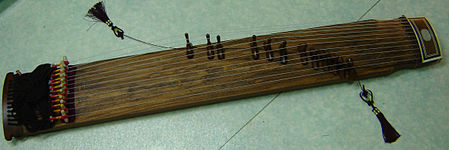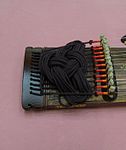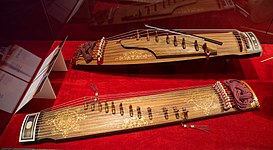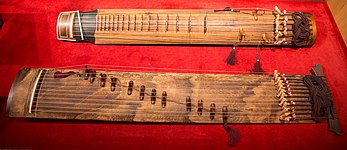Gayageum
Gayageum, also kayagŭm (Korean 가야금), is a vaulting board zither played in Korean classical music. It is a leading representative of Korea's national musical culture.
According to legend, the gayageum was invented by King Kasil on the model of the Chinese arched-board zither guzheng. The instrument can be traced back to 551 AD, when a refugee from the land of Kaya, fearing annexation, fled to Silla and gave the king Kaya's new instrument, a gayageum, as a gift.
There are two traditional types of gayageum: the jeongak gayageum ("court gayageum", also popkum and pungnyu gayageum) and the sanjo gayageum. Typical of the jeongak gayageum is the larger body, which is about 160 centimeters long and 30 centimeters wide, and the lower end of the instrument, which is reminiscent of ram's horns. The sanjo gayageum is about 142 centimeters long and 23 centimeters wide and was developed in the 19th century for the sanjo style. The closer arrangement of the strings and the shorter length of the instrument facilitate the faster passages of the sanjo. Both instruments have twelve silken strings (today also nylon strings) and twelve movable bridges shaped like the feet of wild geese.
· Korean arched board zither - Gayageum - 가야금
· 
Sanjo gayageum - 산조 가야금, 散調伽倻琴, 2005
· 
Zither - Detail, 2005
· 
Sanjo ajaeng and Sanjo gayageum (below), 2017
· 
six-string geomungo (above) and twelve-string jeongak gayageum, 2017
The tuning of the sanjo gayageum is G - c - d - g - a - c1 - d1 - e1 - g1 - a1 - c2 - d2. Two modes of notation are common. If the treble clef is used for notation, the notation is in F, so the notes sound a fifth lower than notated. If the mezzo-soprano clef is used for notation, the notes sound as notated. Unlike the guzheng or Japanese vaulting zither koto, the strings are plucked with the fingertips or nails of the right hand. The sound is soft and singing. The sound of the left hand is similar to that of the koto.
The gayageum is usually accompanied by the dubious hourglass drum janggu.
It is possible that the gayageum influenced the Japanese wagon. Furthermore, the gayageum is related to the Korean bowed zither ajaeng, the Mongolian yatga and the Vietnamese đàn tranh.
Questions and Answers
Q: What is the gayageum?
A: The gayageum is a zither-like string instrument that is traditional to Korea.
Q: How many strings does the gayageum have?
A: The gayageum typically has 12 strings, but some newer versions have 21 or a different number of strings.
Q: What is the body of the gayageum made of?
A: The body of the gayageum is typically made of Paulownia wood.
Q: Is the gayageum a well-known instrument?
A: Yes, the gayageum is probably the best known traditional Korean musical instrument.
Q: Is the gayageum unique to Korean culture?
A: Yes, the gayageum is a traditional Korean instrument and is not commonly found outside of Korea.
Q: What is the difference between newer and older versions of the gayageum?
A: Newer versions of the gayageum may have more strings than traditional versions, which typically have 12 strings.
Q: How does the gayageum sound?
A: The gayageum produces a unique and distinctive sound due to its zither-like design and use of strings.
Search within the encyclopedia